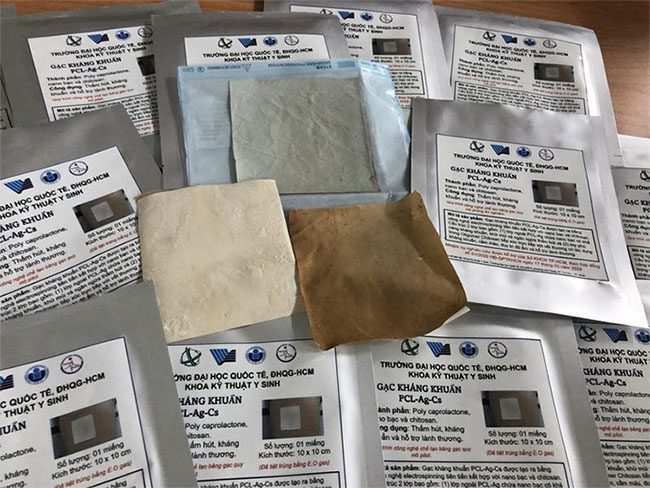Depending on the condition of the skin injury, users (whether doctors or patients) will choose the appropriate type of bandage.
The bandage not only isolates the wound from the external environment but also promotes quick healing and minimizes pain, as researched by Associate Professor Dr. Nguyen Thi Hiep, which is now ready for market launch.
Improving the Production Process
The production process of antibacterial film materials for bandage manufacturing at the pilot scale, perfected by Associate Professor Dr. Nguyen Thi Hiep and her research team at the International University (Vietnam National University, Ho Chi Minh City), is ready for transfer to units interested in producing medical bandages with antibacterial properties that aid in quick wound healing.
According to Associate Professor Dr. Nguyen Thi Hiep, when the skin is injured, the wound will heal naturally over time. However, even minor skin injuries can take longer to recover or become infected if not treated and protected properly. The process of skin wound healing is dynamic and extremely complex, requiring an appropriate environment to accelerate healing.

Antibacterial bandage product produced in trials.
Depending on the condition of the skin injury, users (whether doctors or patients) will select the appropriate bandage type. Bandages are typically made from various natural or synthetic materials and may be biodegradable or non-biodegradable.
Many bandages are constructed with multiple layers, each having different properties. For example, a four-layer bandage may consist of a woven layer, a foam layer, a moisture-retaining layer, and an adhesive layer. Typically, these bandages contain antimicrobial agents such as silver (Ag), bismuth, chlorhexidine, and polyhexamethylene biguanide…
However, the types of bandages that actively support the healing process and possess antimicrobial properties are still not widely produced in Vietnam and are mostly imported. Currently, domestically produced bandages primarily use non-woven fabric techniques and are limited in their incorporation of active ingredients.
“Because there are no antibacterial active ingredients and components to aid in wound healing, conventional bandages are mainly used for physical isolation of wounds from the external environment. These products are less effective in preventing pathogens such as bacteria or fungi,” stated Associate Professor Dr. Nguyen Thi Hiep.
By utilizing the electrospinning technique for nanofiber production, the research team has developed a bandage product that can be combined with various active ingredients to enhance its biological properties supporting wound healing.
The team created a PCL solution containing silver nanoparticles to form a PCL film loaded with silver nanoparticles and manufactured an Oligomer Chitosan spray film. Using these materials, the team produced a bandage from PCL-Ag-Cs film, consisting of two layers: a PCL film containing silver nanoparticles (synthesized via electrospinning) and a mixed coating of oligomer chitosan (Cs) and polyvinylpyrrolidone (PVP).
“The results from the pilot-scale tests of the PCL-Ag-Cs film properties are comparable to those produced at the laboratory scale,” confirmed Associate Professor Dr. Nguyen Thi Hiep.
Supporting Wound Healing and Cell Proliferation
According to Associate Professor Dr. Nguyen Thi Hiep, among the materials used for film production, PCL is emphasized due to its excellent mechanical properties and high biocompatibility. PCL films made using electrospinning are very resistant to deformation under body temperature and room temperature conditions.
The electrospinning film technology is a simple method but offers high economic efficiency due to its ability to produce thin films, leading to fuel savings during the manufacturing process.
In addition to mimicking the properties of traditional bandages, bandages made using the electrospinning method have many advantages, such as being breathable, easy to synthesize, and especially easy to incorporate additional substances to enhance antibacterial properties like Ag, gentamicin, or promote healing with proteins and cell proliferation agents.
The electrospun products obtained feature a microstructure of countless intertwined polymer fibers, ranging in diameter from a few hundred nanometers to several micrometers.
According to Associate Professor Dr. Nguyen Thi Hiep, thanks to the addition of an oligomer chitosan coating, the PCL-Ag-Cs bandage product not only exhibits antibacterial properties but also keeps the wound ventilated and absorbs excess fluids, enhancing the effectiveness of the healing process.
In trials on rabbits, after 30 days, wounds treated with the PCL-Ag-Cs bandage showed better healing results compared to those treated with cotton bandages. Additionally, the product can also be used for burn wounds.
Associate Professor Dr. Nguyen Thi Hiep also noted that the product consists of a film and a coating. The antibacterial component of the bandage is silver nanoparticles and chitosan. The coating serves to keep the wound ventilated and absorb excess wound fluids, thereby improving healing efficiency.
She stated that domestically produced antibacterial bandages provide an opportunity for high-quality medical products at reasonable prices for the general public.
Moreover, this creates opportunities for manufacturers and production units to collaborate and participate in producing the equipment needed for the production process of these bandages, such as coating and drying equipment.


















































